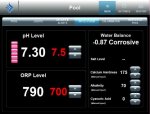I've been soaking up information for the past 6 months, and Thursday was the official go-live date for firing things up so time to put into practice what I've learned here. I think that I'm just looking for reassurance...?
So I ran my first tests this weekend with the TF100 using a speed stir. My water is cold (47 degrees), and I just added salt on Saturday afternoon. Gas line hookup is tomorrow, so it should start warming up after that. Pool was filled with city water, and the pool company that shut it down and opened it up dumped some "things" in when they did it. I know one was polyquat. They said they added algaecide when they started it on Thursday too. I added bleach yesterday afternoon because my SQG won't run yet (water is too cold) - prior to that FC was at 0.
Test sample was taken Sunday Evening - I did the FC and PH tests right away, and then let the water warm up to room temperature before doing the rest.
FC 2.5
CC 0.5
PH 7.3
TA 70
CH 175
CYA - not registering at all
Salt - 4000
The IntelliChem screen is a little scary. It shows that my water is corrosive (using LSI - I see the same thing when I look here and plug in my numbers: Pentair - Saturation Index Calculator). Do I have to worry about this?

Here's what I know (feel free to correct any of these if I'm wrong, I'm still learning here ):
):
* When the water warms up (tomorrow if everything goes well with the gas line), the LSI will increase becoming less corrosive.
* My PH will likely drift higher, also increasing LSI
* I need to add CYA, probably to about 30 to give me the maximum CYA benefit and still allow for my intellichem ORP to maybe, possibly work...this will cause LSI to drop becoming more corrosive. This will put my FC target between 4-6 according to pool math.
My intellichem manual says that for my vinyl pool I should have:
TA: between 125 - 170
CH: between 200 - 500
Pool School Recommended levels say this:
Vinyl with SWG
TA 60-80
CH 0-300 (Don't add)
If you can't tell, I'm a little analytical. Just want to make sure that I have this right in my goal setting. I know that TFP recommendations differ from APSP, just trying to figure out if I need to worry about LSI. Going higher on TA and CH seems to increase LSI, but puts me outside of the TFP recommendations.
So I ran my first tests this weekend with the TF100 using a speed stir. My water is cold (47 degrees), and I just added salt on Saturday afternoon. Gas line hookup is tomorrow, so it should start warming up after that. Pool was filled with city water, and the pool company that shut it down and opened it up dumped some "things" in when they did it. I know one was polyquat. They said they added algaecide when they started it on Thursday too. I added bleach yesterday afternoon because my SQG won't run yet (water is too cold) - prior to that FC was at 0.
Test sample was taken Sunday Evening - I did the FC and PH tests right away, and then let the water warm up to room temperature before doing the rest.
FC 2.5
CC 0.5
PH 7.3
TA 70
CH 175
CYA - not registering at all
Salt - 4000
The IntelliChem screen is a little scary. It shows that my water is corrosive (using LSI - I see the same thing when I look here and plug in my numbers: Pentair - Saturation Index Calculator). Do I have to worry about this?

Here's what I know (feel free to correct any of these if I'm wrong, I'm still learning here
* When the water warms up (tomorrow if everything goes well with the gas line), the LSI will increase becoming less corrosive.
* My PH will likely drift higher, also increasing LSI
* I need to add CYA, probably to about 30 to give me the maximum CYA benefit and still allow for my intellichem ORP to maybe, possibly work...this will cause LSI to drop becoming more corrosive. This will put my FC target between 4-6 according to pool math.
My intellichem manual says that for my vinyl pool I should have:
TA: between 125 - 170
CH: between 200 - 500
Pool School Recommended levels say this:
Vinyl with SWG
TA 60-80
CH 0-300 (Don't add)
If you can't tell, I'm a little analytical. Just want to make sure that I have this right in my goal setting. I know that TFP recommendations differ from APSP, just trying to figure out if I need to worry about LSI. Going higher on TA and CH seems to increase LSI, but puts me outside of the TFP recommendations.
- Since I have to run CYA a little lower trying to get the ORP to work, does this impact what I should be doing with anything else, like TA and CH? It seems that if I increase any of these my LSI increases making my water less corrosive...
- I'm right in line with the Pool School Recommendations, do I even need to worry about LSI? I didn't know what it was until I read the word "corrosive" on my intellichem screen and started reading...and I'm worried about the equipment - from what I've read, corrosive is bad for gunite / concrete - not sure what effects it has on my pump / heater / swg, etc.

